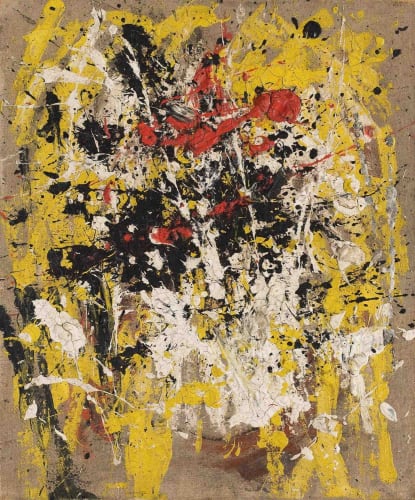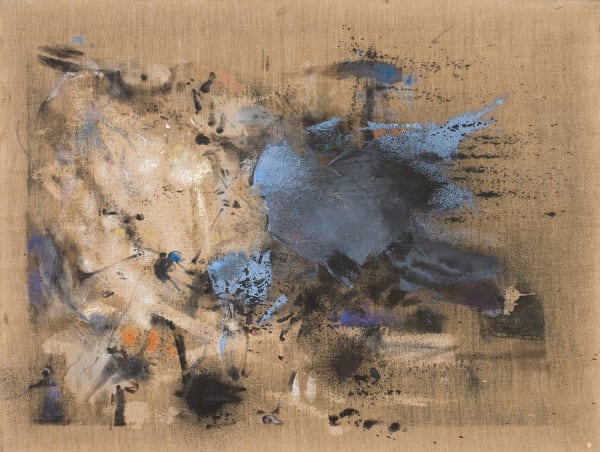JOHN LATHAM: The Spray Gun and the Cosmos
A lost collection of 15 spray-gun paintings by John Latham (1921 - 2006) is to be exhibited publicly for the first time in fifty years.
John Latham has become increasingly recognised as one of the most radical and influential British artists of the second half of the 20th century. Belonging to no specific movement, Latham opened a vast range of possibilities to the British avant-garde. He achieved notoriety for his work Still and Chew (coll. MoMA, New York) which involved chewing, spitting and subsequently distilling a seminal book on art theory by the critic Clement Greenberg. His influence on the subsequent generation of artists, from Richard Hamilton to the YBAs is considerable and he has been consistently acknowledged as a father figure to the current avant-garde.
Latham's practice was highly experimental; he was an artist fascinated by the fusion of science with artistic intuition. Central to Latham's work of the 1950s was the theory that the most basic component of reality is not the particle (as stated in classical physics), but the least-event, defined as a fundamental unti of time, representing state zero for the cosmos and for painting. Producing a single burst of dots on a white surface, his spray-gun paintings function as a visible description of this theory.
Latham called his spray-gun paintings 'process sculpture'. They form the gensis of his later work and define his visual language. As a body of work their radicalism is demonstrated by what is considered to be the first use of the spray-gun in fine art. These paintings led ultimately to the one-second drawings of the 1970s. This exhibition showcases a hugley innovative and significant body of work that is yet to be properly examined.
This collection of 15 paintings was first exhibited in the mid-fifties at the Obelisk Gallery in London. They were subsequently sold at the Six Bells pub in Chelsea in the late 60s and this is the first time they have been seen since.
This will be the first London exhibition since Latham's controversial display at Tate Britain in 2005 and the first since the artist's death.
-
 John LATHAMUntitled, 1954oil on unprimed canvas77 x 63 cm
John LATHAMUntitled, 1954oil on unprimed canvas77 x 63 cm
30.3 x 24.8 in -
 John LATHAMUntitled, 1954spray paint and emulsion on unprimed canvas40 x 25 ins
John LATHAMUntitled, 1954spray paint and emulsion on unprimed canvas40 x 25 ins
101.6 x 63.5 cm -
 John LATHAMCorpus Ballet, 1955Spray paint and emulsion on maisonite153 x 90 cm
John LATHAMCorpus Ballet, 1955Spray paint and emulsion on maisonite153 x 90 cm -
 John LATHAMSleep, 1955spray-paint and emulsion on board122 x 91 cm
John LATHAMSleep, 1955spray-paint and emulsion on board122 x 91 cm
48 x 35.8 in -
 John LATHAMUntitled, 1955spray paint and emulsion on unprimed canvas76 x 101 cm
John LATHAMUntitled, 1955spray paint and emulsion on unprimed canvas76 x 101 cm
29.9 x 39.8 in -
 John LATHAM, Untitled, 1956
John LATHAM, Untitled, 1956 -
 John LATHAMTwo Figures, 1957spray paint, emulsion and plaster on unprimed hardboard in original artists frame158 x 89 cm unframed
John LATHAMTwo Figures, 1957spray paint, emulsion and plaster on unprimed hardboard in original artists frame158 x 89 cm unframed
62.2 x 35 in unframed -
 John LATHAMTwo-Sided Painting, 1957oil on unprimed canvas103.6 x 78.5 cm
John LATHAMTwo-Sided Painting, 1957oil on unprimed canvas103.6 x 78.5 cm
40.8 x 30.9 in -
 John LATHAM, Untitled, 1957
John LATHAM, Untitled, 1957









